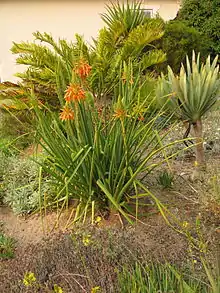Aloe cooperi
Aloe cooperi, also known as Cooper's aloe[3] and as iPutumane in Zulu, is a succulent species that is endemic to Southern Africa. It has significant cultural and economic value to the Zulu people of South Africa.
| Aloe cooperi | |
|---|---|
 | |
| Scientific classification | |
| Kingdom: | Plantae |
| Clade: | Tracheophytes |
| Clade: | Angiosperms |
| Clade: | Monocots |
| Order: | Asparagales |
| Family: | Asphodelaceae |
| Subfamily: | Asphodeloideae |
| Genus: | Aloe |
| Species: | A. cooperi |
| Binomial name | |
| Aloe cooperi | |
| Synonyms | |
|
Aloe schmidtiana Regel | |
Distribution
This plant can be found along the southern warm coastal parts of Kwazulu-Natal and north up to the colder mountainous regions of Swaziland and Mpumalanga.[4]
Uses
- Young shoots and flowers are often cooked and eaten as vegetables by the Zulu people, they also believe that smoke from burning leaves in the cattle kraal will prevent the effects on cattle of eating improper food.[5]
- The plant's juice has been fed to horses to rid them of ticks.[6]
- The plant attracts nectar feeding birds, this made it a popular garden plant in South Africa.[7]
References
- "Aloe cooperi Baker". Plants of the World Online. The Trustees of the Royal Botanic Gardens, Kew. n.d. Retrieved July 16, 2020.
- "Aloe cooperi Baker". World Flora Online. The World Flora Online Consortium. n.d. Retrieved July 16, 2020.
- "ITIS - Aloe cooperi". Integrated Taxonomic Information System. Retrieved 31 December 2015.
- Court, Doreen (2000). Succulent Flora of Southern Africa. CRC Press. ISBN 9789058093233.
- "Aloe cooperi". www.plantzafrica.com. Retrieved 2015-12-31.
- "Operation wildflower".
- "Aloe cooperi". lifestyleseeds.co.za. Retrieved 2015-12-31.
This article is issued from Wikipedia. The text is licensed under Creative Commons - Attribution - Sharealike. Additional terms may apply for the media files.